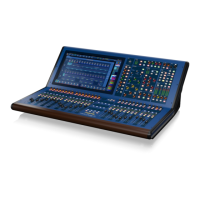110 HD96-24-CC-TP User Manual
Solo System Conguration
Solo A and Solo B system sections allow solo signals to be selected independently for each monitor system (A and B). These can be selected as AFL (PFL extinguished),
PFL (PFL illuminated), additive (ADD enabled) or interlock cancelling (ADD disabled).
Each of these modes changes the interleaving logic between diering areas of the monitor output. A mode select button scrolls through the possible options.
Additionally, there is a Solo In Place button for activating the SIP function.
Sources
The Source A and Source B sections contain monitor input selector switches in the Monitor Conguration page. On both the A and B systems, these dene the source
for the monitor section from the possible ‘primary’ choice of stereo master (ST), mono master (MONO) or Solo-Source External (EXT). Additionally, each section has a
talkback button (talkback is a line level input on the back of the surface).
The function of the buttons in each source section is as follows:
1. Talkback [A and B] switches, sums the line level talkback input from the rear of the surface to the solo bus.
2. Stereo – Routes post-fader stereo master mix to stereo local monitor outputs.
3. Solo – Source External switch, routes stereo external input (two-track return etc.) to stereo local monitor outputs.
4. Solo Mono switch, routes post-fader mono masters mix to stereo local monitor outputs.
Summing
Each monitor bus has the following functions:
1. Mono – Sums left and right to mono. Great for checking stereo signals for polarity and phase issues.
2. Polarity – Inverts the right side of the monitor bus by 180°.
3. Left to Right – Sends the left monitor bus signal to both left and right sides of the selected monitor bus.
4. Right to Left – Sends the right monitor bus signal to both left and right sides of the selected monitor bus.
Note: pressing both Left and Right to Both swaps the left and right signals in the solo bus.

